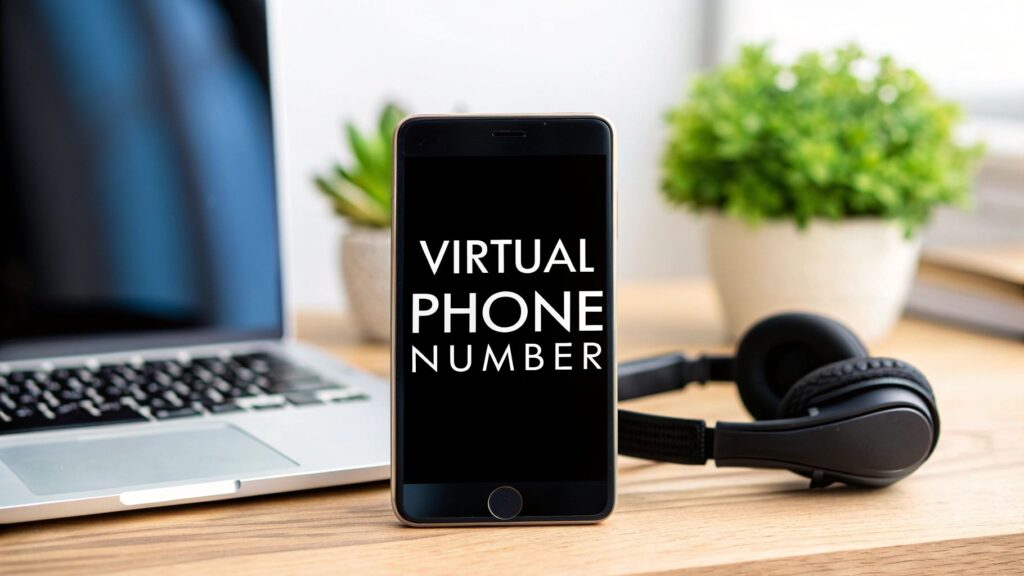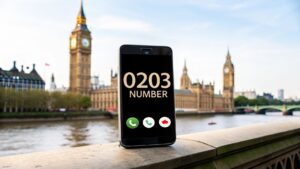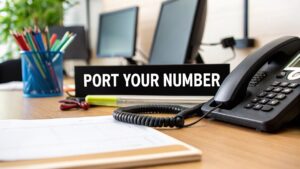Imagine having a dedicated business number that rings on your mobile, your laptop, or even your team members' phones—no matter where they are. That’s the simple, powerful idea behind a virtual phone number for business. It’s a proper phone number, just like any other, but it works over the internet, giving you complete freedom to direct calls to any device you choose. For UK startups, freelancers, and businesses with remote teams, it's an absolute game-changer.
What Exactly Is a Virtual Business Phone Number?
So, what are we really talking about here? Let's ditch the jargon. A virtual business phone number is essentially a clever forwarding service for your calls. When someone dials your business number, the system doesn't make a single, physical phone on a desk ring. Instead, it instantly reroutes the call to the phone numbers you’ve chosen beforehand.
This could be your personal mobile, a colleague's phone across the country, your home landline, or a software-based phone (a "softphone") on your computer. Your customer has no idea this is happening; they just dial a normal-looking business number and get put through. For you, it means you can manage all your business calls from anywhere, on any device.
It's the perfect way to keep your business and personal calls separate, even if you’re using just one smartphone. You'll always see when a business call is coming in, so you can answer professionally every single time. It lets you project a polished, established image without the expense and hassle of old-school phone systems.
Traditional Phone Line vs Virtual Phone Number
To really grasp the difference, it helps to see them side-by-side. The old way of doing things involved a lot of hardware and physical limitations, whereas the new way is all about software and flexibility.
| Feature | Traditional Phone Line | Virtual Phone Number |
|---|---|---|
| Cost | High setup fees, line rental, and expensive hardware. | Low monthly subscription, minimal setup cost, no hardware needed. |
| Flexibility | Tied to a single physical location (the office). | Works anywhere with an internet connection. |
| Hardware | Requires desk phones, a PBX system, and physical wiring. | Uses existing devices like mobiles, laptops, or tablets. |
| Features | Basic features like call waiting and voicemail. | Advanced features: call routing, auto-attendant, analytics, etc. |
| Scalability | Adding new lines is slow and costly. | Add or remove numbers and users instantly online. |
The contrast is pretty stark. Virtual numbers are built for the way businesses operate today—dynamically and often without a central office.
The Technology Behind It All
This all works thanks to a technology called Voice over Internet Protocol, or VoIP. It’s a fancy term for a simple concept: your voice is converted into digital data and sent over the internet, instead of through the old copper wires of a traditional phone line. If you've ever made a call on WhatsApp or joined a Zoom meeting, you've already used VoIP.
Because it's based on software, not hardware, a virtual number comes packed with incredibly useful features that traditional phones simply can't match:
- Call Routing: Cleverly direct calls based on the time of day, which team member is free, or even menu options the caller selects (e.g., "Press 1 for Sales, Press 2 for Support").
- Auto-Attendant: Set up a 'digital receptionist' to greet callers with a professional message and guide them to the right person.
- Voicemail-to-Email: Get your voicemails sent straight to your inbox as an audio file, often with a text transcription. No more dialling in to check messages.
- Professional Greetings: Record custom welcome messages and choose your own on-hold music to create a consistent brand experience.
Why It Matters for UK Businesses
This isn't just a fleeting trend; it represents a fundamental shift in business communications. With the UK's big PSTN switch-off set for 2027—when all traditional phone lines will be retired in favour of internet-based technology—moving to a virtual number now is just smart planning. It’s about future-proofing your business.
For a modern business, a virtual phone number isn't just a handy tool; it's a strategic asset. It gives a small startup the presence of a large corporation and allows teams to work from anywhere without ever missing a customer call.
The financial upside is just as compelling. By 2025, virtual numbers have become essential, slashing startup costs by up to 90% by eliminating the need for pricey hardware and maintenance contracts. UK companies can pick from over 2.95 million virtual numbers across 520 towns and cities, giving them an instant, trusted local presence wherever they need it. If you're interested in the data, you can read more about the findings on UK virtual number adoption.
The Real-World Benefits of a Virtual Number

Understanding the tech is one thing, but the real magic is in how a virtual number can genuinely improve your business. Let’s look past the jargon and explore how a virtual phone number for business makes a tangible difference to your daily operations, your professional image, and, ultimately, your bottom line.
For many small businesses and freelancers, the first big step is looking the part. A virtual number immediately gives you a dose of professional credibility. It provides a dedicated business line that tells the world you’re a serious, established operation, not just someone running a side hustle from their kitchen table.
This simple shift can completely change how potential customers see you from that very first contact. When they find a proper business number on your website or the side of your van, it builds instant trust—a vital ingredient for winning new clients.
Create a Professional Brand Image
Answering a call from a potential client with a casual "Hello?" on your personal mobile can shatter a professional impression in an instant. A virtual number solves this problem completely. It identifies incoming business calls, so you can pick up with the right greeting every single time.
Think of a freelance web designer in Leeds. With a virtual number, every call is a business opportunity, answered with a confident "Good morning, [Your Business Name]," instead of a hurried and informal greeting meant for a mate. It’s a small change, but it makes a world of difference to a client's confidence.
A virtual number gives your small operation the polished front-end of a much larger company. It’s about creating a consistent, professional experience that encourages customers to trust you with their business.
You can also set up a custom voicemail specifically for your business. This means that even if you miss a call, the customer is greeted by a professional, reassuring message, confirming they’ve reached a legitimate company.
Reclaim Your Work-Life Balance
One of the biggest challenges for any entrepreneur is drawing a line between work and personal life. That line gets incredibly blurry when your personal mobile number is also your business line. A virtual phone number for business creates a clear, healthy separation.
You no longer have to hand out your private number to clients, suppliers, or marketing agencies. This is huge. It protects your personal time and privacy, stopping business calls from interrupting family dinners or your weekends.
Most virtual number services let you set specific business hours. In practice, it works like this:
- During your set business hours: Calls come through to your phone as usual.
- Outside of these hours: Calls are automatically sent to your professional voicemail. You won't miss out on leads, but you also get to protect your downtime.
This feature is an absolute game-changer for your well-being. It gives you permission to properly switch off, knowing your business calls are still being handled professionally and efficiently while you're away.
Slash Costs and Boost Flexibility
Let’s be honest, traditional phone systems are expensive. They often come with hefty costs for hardware, line rental, and ongoing maintenance. A virtual number sidesteps all of that.
Because it works over the internet using the devices you already have—like your smartphone or laptop—there’s no need for clunky office phones. This can lead to massive savings, sometimes up to 90% on setup costs compared to an old-fashioned landline system.
But it’s not just about saving money; it’s about gaining freedom. This cost-efficiency comes with incredible flexibility. Whether you’re working from a home office in Cardiff, a co-working space in London, or a coffee shop in Glasgow, your business number travels with you. As long as you have an internet connection, you can make and take calls, ensuring you’re always there for your customers.
For businesses with remote or hybrid teams, this kind of mobility isn't just a nice perk—it's essential for keeping everyone connected and delivering great service.
Choosing the Right Type of UK Virtual Number

Picking a virtual number isn't just a technical task; it's a strategic decision that directly shapes how customers see your business. The digits you choose send a powerful message. The right one can build local trust, project a national presence, or even make customers more likely to call you.
Think of your phone number like an outfit for a business meeting. A local number feels familiar and approachable, perfect if you're embedded in a community. A national number, on the other hand, suggests scale and authority. Let’s break down the different types of UK virtual numbers to help you find the perfect match for your business.
Build Community Trust with Local Numbers (01/02)
For any business that depends on a local customer base, a local number is practically essential. These are the numbers that start with familiar area codes—think 0161 for Manchester, 0121 for Birmingham, or 020 for London. When a potential customer sees an area code they recognise, it creates an instant sense of trust and familiarity.
Picture yourself as a plumber in Bristol. An 0117 number immediately tells local residents you're part of their community, not some faceless national chain. It suggests you can probably get to them faster and offer a more personal service. This can give you a real edge over a competitor using a generic mobile number or a non-local code.
A local number says, "I'm one of you." It breaks down that invisible barrier and makes customers feel more comfortable picking up the phone, knowing they're dealing with a nearby business.
This local connection is a game-changer for service-based businesses, from electricians and hairdressers to local cafés and independent consultants. It makes you feel accessible and properly established in the area.
Project a UK-Wide Presence with National Numbers (03)
But what if your customers are spread all over the UK? For an e-commerce store, a national consultancy, or a software company, a national number (starting with 03) is often the smarter choice. These numbers aren't tied to a specific city or town, which instantly gives your business a bigger, more professional footprint.
What's more, customers from anywhere in the UK can call an 03 number for the same cost as a standard landline call. In many cases, these calls are included in their free minute bundles, removing any hesitation about dialling a "long-distance" number.
An 03 number is the perfect fit if:
- You run an online shop shipping products across the country.
- You're a consultant or coach with clients nationwide.
- You operate a national support line for a software product.
Using an 03 number clearly signals that you’re a UK-wide operation, ready to do business with anyone from Aberdeen to Cornwall.
Go Mobile with 07 Numbers for SMS and WhatsApp
In a world where many customers prefer to text rather than talk, an 07 mobile virtual number is an incredibly useful tool. While traditional virtual numbers are all about calls, an 07 number brings your business straight into the world of SMS and WhatsApp Business. It's ideal for those quicker, less formal interactions.
This unlocks a whole new way to communicate, giving you access to WhatsApp Business profiles, product catalogues, and automated replies. A handyman can get job photos sent via WhatsApp, or an e-commerce store can send order updates by text. The UK virtual phone number market now offers a wealth of options, which is fantastic for businesses wanting a strong presence. With choices including local (01/02), mobile (07), and toll-free (0800) numbers, companies can significantly improve customer interactions and track marketing far more effectively. You can discover more about how UK businesses use virtual numbers on callatlas.io.
Encourage Calls with Toll-Free Numbers (0800/0808)
If you want to remove every single barrier that might stop a customer from contacting you, a toll-free number is the gold standard. These numbers, which start with 0800 or 0808, are completely free for the caller to dial from any UK landline or mobile. This simple fact can dramatically increase the number of enquiries you receive, especially for sales lines or customer support hotlines.
A toll-free number sends a clear message: you value your customers and are willing to invest in making their experience easy. It's particularly effective for national retailers, insurance companies, or any business where high-volume customer interaction is the key to success.
Must-Have Features for Your Virtual Phone System
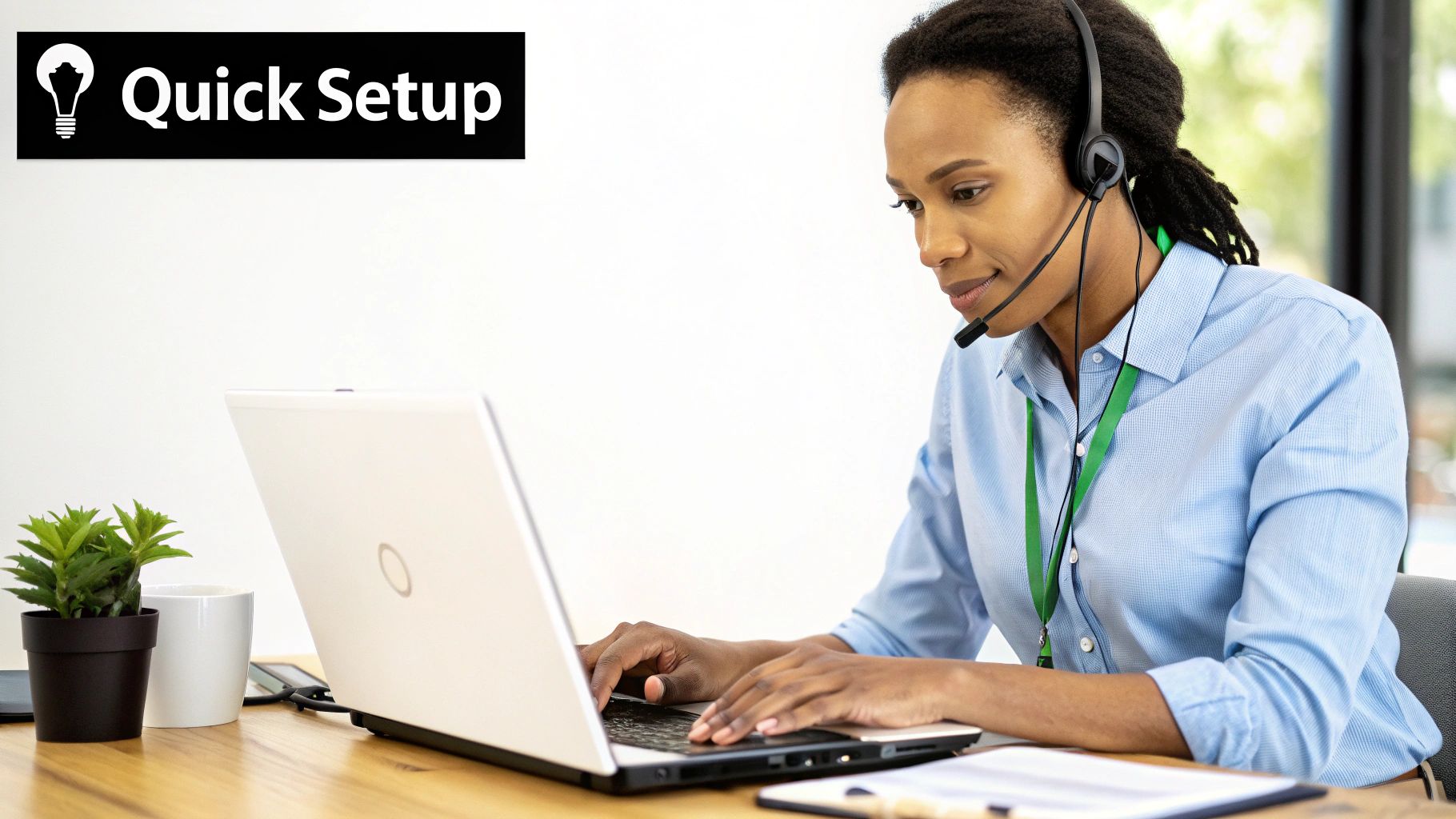
Choosing a virtual phone number for business is a great start, but it's really just the first step. The number itself is the foundation, but the features your provider offers are what truly transform your communications. Think of it like a high-performance car – the shiny exterior is your number, but its real power comes from the engine and technology under the bonnet.
When you're shopping around, you aren't just buying a number. You're investing in a suite of tools designed to make your business run more smoothly, present a more professional image, and ultimately, drive growth. These are the features that separate a basic service from a system that actively helps you manage customer relationships and seize every opportunity.
The Auto-Attendant or Digital Receptionist
Picture a potential client calling your business for the first time. Instead of an abrupt ring or a rushed, unprofessional "hello?", they're greeted by a calm, clear voice: "Thank you for calling [Your Business Name]. To speak with our sales team, please press 1. For customer support, press 2."
That’s an Auto-Attendant in action, and it’s like having a digital receptionist on duty 24/7. It immediately gives your small business the polished feel of a much larger, well-organised company. More importantly, it directs callers to the right person or department straight away, creating a seamless and efficient experience from the get-go. This one feature can prevent customer frustration and get people the help they need, faster.
Intelligent Call Routing
What happens when a crucial call comes in while you're already on another line or away from your desk? Without the right setup, that opportunity could easily be missed. Intelligent call routing is your safety net, making sure every single call finds its way to the right person, no matter the circumstances.
You can set up rules that fit how your business operates. For instance, a "ring group" can make several team members' phones ring at the same time, so the first person available can grab the call. This is perfect for a busy sales team where speed is everything.
Alternatively, you could create a 'hunt group' that tries people in a specific sequence. The call might ring your phone first, then your business partner's if you don't answer, and finally a colleague's. It’s a clever way to share the workload and ensure a human voice always answers.
Modern virtual phone systems are built to scale with you. Adding new users and lines is often as simple as a few clicks in an online dashboard, with no need for costly hardware or technician visits.
Voicemail to Email and Transcription
Nobody has time to constantly check a traditional voicemail inbox. Dialling in, listening to messages, and scribbling down notes feels like a relic from another era. Modern virtual phone systems fix this with voicemail-to-email functionality.
When a caller leaves a message, the system automatically zips the audio file over to your email inbox. You can listen to it on any device, forward it to a colleague, or archive it for your records. It’s faster, more organised, and just far more convenient.
Many providers take this a step further with voicemail transcription. The system uses AI to convert the spoken message into text, which is then included in the email. Now you can simply read your voicemails at a glance, whether you’re in a noisy place or a quiet meeting. It's a massive productivity boost.
CRM Integration for Smarter Conversations
Your Customer Relationship Management (CRM) system is the brain of your client operations. It stores every little detail about your customer interactions, from past purchases to recent support queries. A virtual phone system that integrates with your CRM connects that data directly to your calls.
Here’s how it works: when a customer calls in, the phone system instantly recognises their number and pulls up their profile from your CRM. Before you even say "hello," you can see who’s calling and their entire history with your business.
This powerful feature gives your team the context they need to have smarter, more personal conversations. You can greet customers by name and reference their previous enquiries, showing them they're valued and understood. As experts on how to get a virtual number at OpenPhone.com explain, automatically logging calls and texts into the CRM also frees your team from soul-destroying admin work.
How to Get Your Virtual Number in 5 Simple Steps
Think setting up a new business phone system is some long, complicated tech nightmare? It's a common worry, but the reality is refreshingly simple. Getting a virtual phone number for business is surprisingly quick – you can often have it sorted in the time it takes to brew a proper cuppa.
Let's walk through the process, step by step, without any confusing jargon. My goal here is to show you just how straightforward it is to get a professional line up and running today.
Step 1: Choose the Right Provider
First things first, you need to pick a service provider that actually fits your business and budget. They aren't all the same. Some are geared towards huge corporations with sprawling call centres, while others, like us at Business Numbers Direct, focus on small businesses and entrepreneurs who need something affordable and easy to use.
A good tip is to look for a provider with a clear, no-contract monthly plan. This gives you the freedom to change things up as your business evolves, without being tied down. You want a partner who makes it quick and painless to get started, not one that overcomplicates things.
Step 2: Select Your New Business Number
Now for the fun part: picking your number. As we've discussed, the number you choose says a lot about your business. You'll usually get a few choices:
- Local Numbers (01/02): Perfect for building trust and a local feel in a specific town or city.
- National Numbers (03): Great if you want to project a UK-wide presence.
- Mobile Numbers (07): A must-have if you plan to use SMS and WhatsApp for business comms.
Think about who you're trying to reach. If you're a local plumber, an area code your customers recognise is a massive advantage. If you run an e-commerce shop shipping across the country, a national or mobile number might make more sense.
Your virtual number is more than just a way for people to call you; it’s a piece of your brand identity. Choose one that reflects the size and personality of your business, helping you connect with the right audience from the very first ring.
Step 3: Configure Your Call Forwarding
This is where the real magic happens. Call forwarding is the heart of a virtual number. All you do is tell the system where you want your business calls to ring. Most providers give you a simple online dashboard or a mobile app to manage it all.
You can point calls to your personal mobile, a colleague's phone, or even a softphone app on your computer. The whole process is designed to be dead simple – no IT degree required. This setup ensures you never miss a crucial call, whether you’re in the office, working from home, or out on the road.
The core idea is incredibly straightforward, as this little diagram shows.
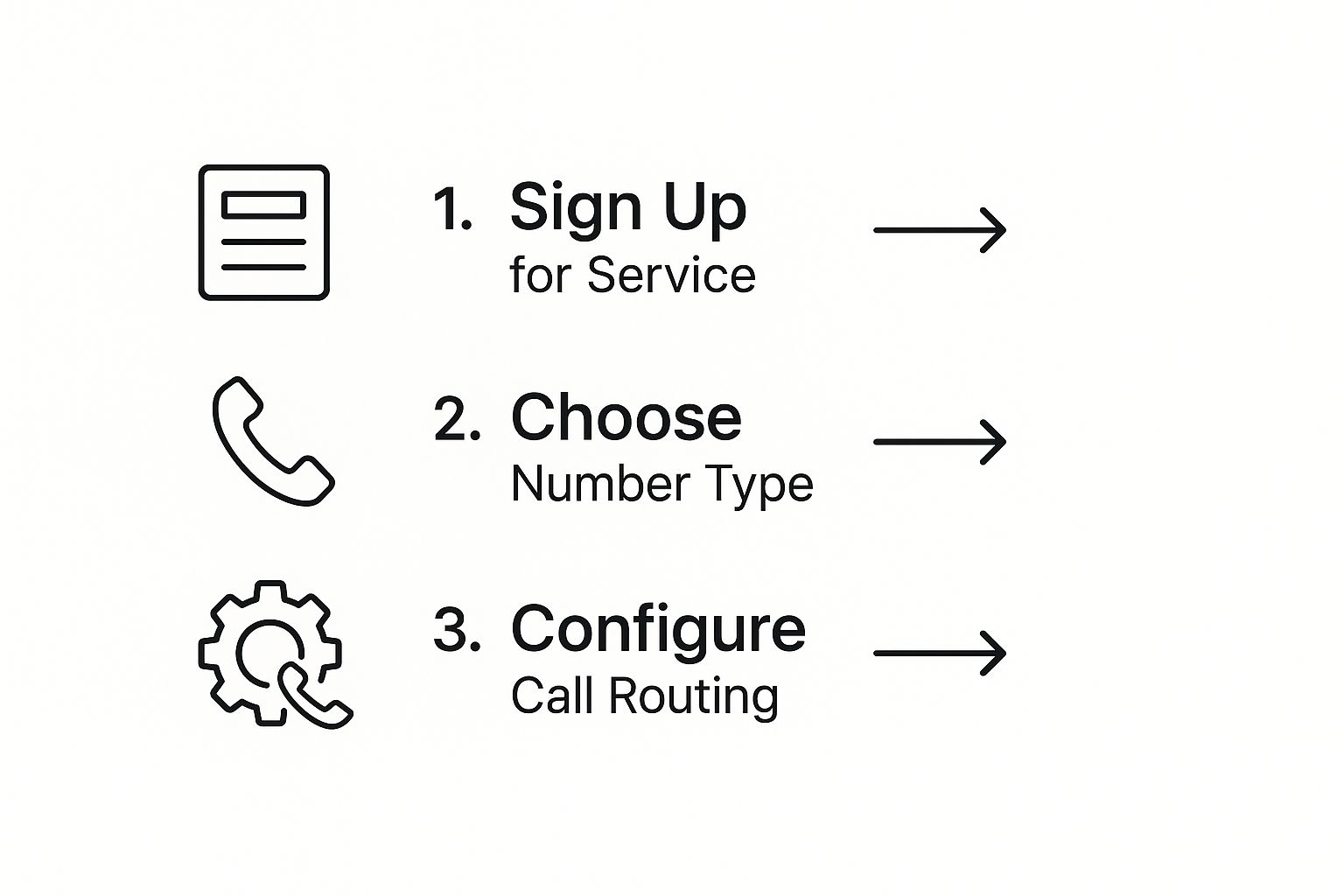
It really is that simple: sign up, pick a number, and decide where the calls should go.
Step 4: Record Your Professional Greetings
First impressions count for everything. A professional welcome greeting instantly makes your business sound more established and reassures callers they're in the right place. Just take a few minutes to record a clear, friendly message.
While you're at it, set up your business voicemail. This makes sure that even if you can't pick up, the customer still gets a professional experience. Keep your message short, state your business name, and promise you'll call them back quickly.
Step 5: Test Your New System
Last but not least, before you splash your new number all over your website and van, give it a proper test run. Get a friend or colleague to call it and go through the whole experience from their side.
Check that the call forwards to the right phone and that your custom greeting plays correctly. Leave a test voicemail to make sure you receive it properly. This final check gives you total peace of mind that everything is working perfectly before your first real customer calls.
How Different UK Industries Use Virtual Numbers
A virtual phone number isn't just a piece of tech; its true power comes to life when you see how it solves real-world business headaches. To give you a better idea of just how adaptable they are, let's walk through a few short stories from different UK sectors. You’ll quickly see how a simple number can become a surprisingly potent tool for growth, efficiency, and looking the part.
Picture a freelance graphic designer working from her home office in Bristol. She needs to project the same level of professionalism as the big agencies. By using a virtual phone number for business with a local 0117 area code, she instantly looks like an established local firm. Potential clients are often more willing to dial a local number, and she gets to keep her personal mobile number private, which is a massive win for work-life balance.
Driving Sales and Building Trust
Now, let's think about a small e-commerce shop selling handmade jewellery online. The team is scattered across the UK, but they want to offer top-notch customer service. Setting up a single 0800 toll-free number gives them a professional and trustworthy point of contact that encourages people to call. Calls can be automatically sent to the next free person, meaning fewer missed sales and happier customers who feel looked after.
A virtual number adapts to your specific industry needs. Whether you're building local trust or a national brand, it provides the right communication tool to help you connect with your customers more effectively.
Managing Enquiries Across Multiple Locations
Or what about an estate agency with branches in Manchester and Liverpool? They use separate local numbers for each city—0161 for Manchester and 0151 for Liverpool. When a call comes in, it's routed to their central team, who can immediately see which number was dialled. This tells them straight away which property market the caller is interested in, allowing for a slick, tailored response while maintaining a strong local feel in both cities.
The flexibility of a virtual phone number for business stretches into almost every corner of the UK economy. By mid-2025, their adoption has soared as businesses realised they offer communication tools that sharpen operations. For example, financial firms use them to create secure, recorded call logs for compliance, while healthcare clinics manage appointments and telehealth sessions.
Even freelancers and consultants use them to appear as a national operation without needing a physical office. It just goes to show how this technology fits perfectly with the way modern businesses work. These examples from The Telephony on UK sector adoption highlight how you could put a virtual number to work in your own industry.
Got Questions About Virtual Business Numbers?
Deciding on a new phone system is a big deal, so it's only natural to have a few questions before you take the plunge. A virtual phone number for business might sound a bit technical, but it’s designed to make your life simpler, not more complicated. Let's walk through some of the common things business owners ask.
We'll tackle the practical worries, from whether the calls sound good to what happens if you ever want to switch providers. The goal is to make sure you feel completely comfortable with the move.
Is the Call Quality as Good as a Landline?
This is usually the first question people ask, and for good reason. The short answer is yes, absolutely—as long as your internet connection is solid. A virtual number uses VoIP (Voice over Internet Protocol), which basically means your calls run over the internet. If your Wi-Fi or mobile data can handle a video call or stream a film without buffering, it's more than capable of delivering crystal-clear voice calls.
In fact, most modern providers use HD voice technology, so you might even find the calls sound richer and clearer than your old landline ever did.
Can I Keep My Existing Business Number?
Of course. You've probably spent years making sure your customers know your number, and you shouldn't have to throw that away. The process is called number porting, and it's a completely standard service that almost every provider offers.
You can bring your current business number over to a new virtual service, and your customers won't notice a thing. It’s a smooth transition that lets you keep your brand identity intact while upgrading your phone system.
Your new provider will sort out all the technical bits behind the scenes. It's a surprisingly simple switch that moves your number to a more flexible and powerful platform.
What Happens if I Switch Providers Later?
That number is yours, not the provider's. If you ever find a better deal or need a service with different features down the road, you can simply port your number again to a new provider. This freedom is one of the best things about modern phone systems—you’re never locked in.
It means you can always pick the service that’s the right fit for your business as it grows, without worrying about losing the number your customers know. You stay in control.
Ready to separate your personal and professional life with a dedicated business number? With Business Numbers Direct, you can get a virtual number for WhatsApp Business set up on your existing phone in minutes, all for just £7.99 a month, contract-free. Get your virtual number today and start building a more professional brand.

